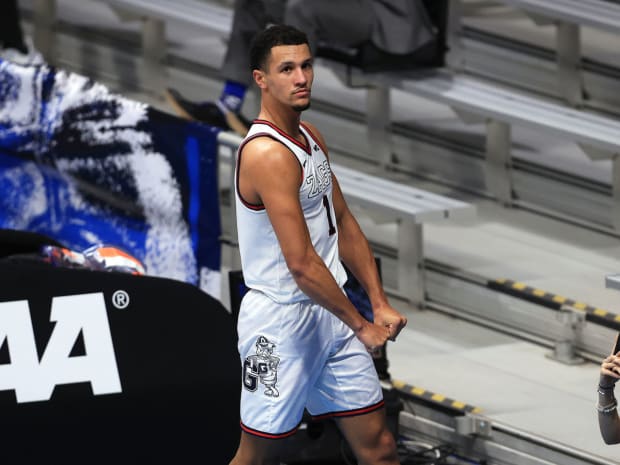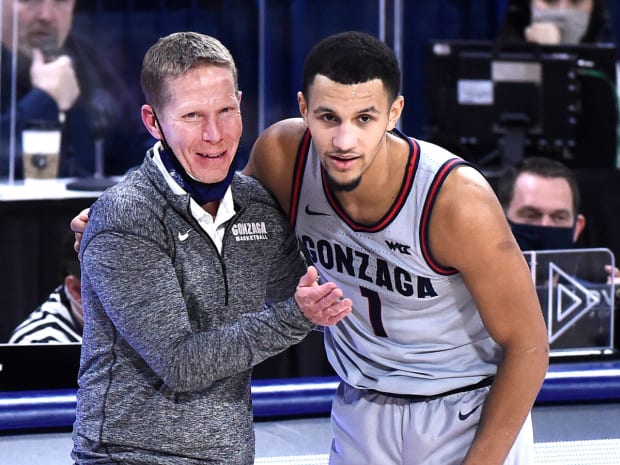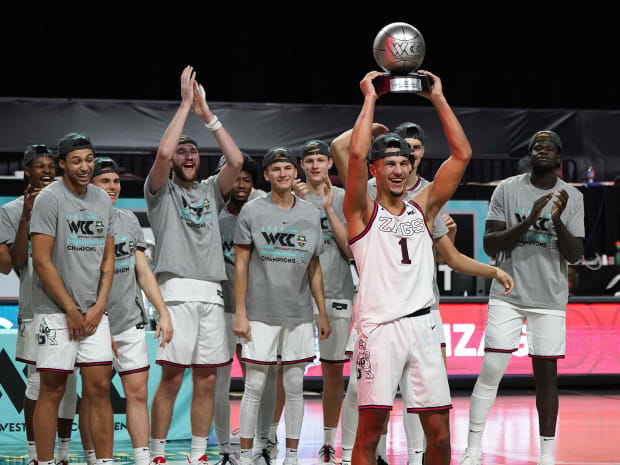Mark Few's program has rarely been a home to one-and-dones, but Suggs not only broke that mold, he's fit in like a glove.
INDIANAPOLIS — Please don’t forget about the block, and the fact that the loudest play of an instant classic belonged to Jalen Suggs long before his One Shining Moment dropped from just inside halfcourt. Lucas Oil Arena was already reeling from the play Suggs had made minutes earlier, before overtime, and a lot of everything else.
The thing you have to understand about the way Suggs, Gonzaga’s unflinching freshman guard, approaches his craft, is that he doesn’t leave much open-ended. To be a closer, you must first be willing to close plays. Suggs does not make every single one—though at times, it can feel that way—but he doesn’t give up on blocks, loose balls, or errant passes. When your gears shift as quickly as his do, leaving anything on the table is kind of a disservice. UCLA’s Cody Riley didn’t see Suggs coming, bearing down with two quick strides and matching him step for step, left arm outstretched. “I couldn’t just give him a free bucket, you know,” Suggs says.
With the game still tied and two minutes on the second-half clock, Suggs got his fingertips to the ball and sent the big man tumbling, with the rock bouncing toward the corner. He collected it in stride and turned up the floor. He needed just a few steps to approach midcourt and see Drew Timme leaking ahead. Suggs does not leave opportunities on the table. And as his second dribble crested, he spun an overhand pass toward the floor, aiming to split three UCLA defenders. “I was not thinking it was going to be one of his greatest decisions he's ever had,” says Gonzaga coach Mark Few. “But he's got a knack, again, for just—I mean, fitting things into small windows.”
The ball hit Timme in stride, caroming off the ground and narrowly past the left hand of UCLA’s Tyger Campbell, on a dead sprint. “It made it a lot closer than I wanted it to be,” Suggs says. Gonzaga’s large, mustachioed talisman elevated for a two-handed slam, punctuated by his ubiquitous, joyful stache-wiping act. Suggs, of course, actually won the game later, pulling up from logo range in a tie game to bank in a season’s worth of expectations, 93–90. He finished with 16 points, six rebounds, five assists, two steals and the block.
“The beauty of Jalen,” Few says, “is he does make plays like that and has made plays like that defensively … because he's so athletic, and he's so tough and he's not afraid. He's not afraid to try. And that's absolutely what he brings to our team. He's elevated us tremendously.”

Long before personally booking his team for a stirring heavyweight date with Baylor, with a championship on the line, Suggs had been doing this. He’s a blink-and-miss-it player who can bend the mood of games with the sheer surprise he inflicts. It only took Suggs a few seconds to announce his arrival in college, after all, his first two points an alley-oop slam that scaled ace Kansas defender Marcus Garrett and ended unpleasantly enough for Suggs to earn his first technical foul, too. You might say the Zags and Suggs arrived together that day in November, his broiling competitive fervor helping spark a statement win against a top-10 team that never felt especially close.
Gonzaga held the No. 1 spot in the men's polls all year for a reason. There has been no point at which that dominance has been much in question. It is 31–0, top-eight in efficiency on both ends of the floor, and boasts the best team two-point shooting percentage on record. The 6' 4" Suggs has been the Bulldogs' engine, with quickness embedded not only in his first step, but the zip on his passes and verve in his decisions. His teammates share the ball obsessively, and he returns the favor. To the naked eye, he’s imbued the Zags’ talented returners with a new level of swagger. “He keeps us going no matter what,” says Zags forward Drew Timme. “He’s a fierce competitor, and it rubs off on the other guys for sure.”
At this point, you probably know a little bit about Suggs. You might have heard he used to play football. The latest in a large family of athletes, as you might imagine, he was pretty good at it. But in Minneapolis’s close-knit basketball community, tales of Suggs’s accolades as a wiry grade-schooler are equally widespread. He earned his first Division I offer in sixth grade, joined the varsity team at Minnehaha Academy in Minneapolis as a seventh grader, nabbed his first high-major offer a year later, and won three straight state titles in high school, missing out on a chance at an elusive four-peat after COVID-19 cut short his senior season. He won three gold medals with USA Basketball’s youth teams, and became the highest-rated recruit in Gonzaga history when he committed.
Maybe everything was building to this. Mark Few bucked convention and built a perennial 30-win program from the ground up. Its staff recruits globally, but keeps a narrow list of targets. Over the years, the team’s profile has increased, and the caliber of player it attracts has gradually risen. But Gonzaga doesn’t cater to everyone. As it happened, Suggs’s recruitment was rooted in mutual interest. Zags assistant Brian Michaelson had been in touch with Brian Sandifer, a close confidant of the Suggs family who runs the twin cities-based Grassroots Sizzle club program. Gonzaga was recruiting North Dakota transfer Geno Crandall to help patch up its backcourt. In those conversations, Sandifer relayed to Michaelson that Suggs’s father, Larry, was drawn to Gonzaga’s style of play. He asked to talk with Few.

At that point, the only one-and-done Gonzaga had produced was Zach Collins, whose NBA stock didn’t take off until late in the 2017 season. He became the 10th pick by the Portland Trail Blazers almost by surprise. When Sandifer reached out, Few was reticent at first, uninterested in what he feared could have been a superficial relationship. In an era where every offer is diagnosed and shared online, Gonzaga does not extend scholarships for show. But the gist of that conversation was simple. “[Few] says, look: if we have a legitimate shot at getting him, you gotta be honest with me,” Sandifer says. And I told him he did. But he was going to have to recruit Jalen himself.”
Faced with a real opportunity to land an instant, program-changing recruit, Few went in full bore. He became a regular at Minnehaha, making the three-hour flight from Spokane at seemingly every opportunity. He became a constant presence at the school, showing up at games, practices and wherever else he was permitted, including a football game in freezing northern sleet. “I started to wonder, when is he coaching at Gonzaga?,” says Minnehaha assistant Randy Carter, who played at Minnesota from 1990–94. “You see these guys walking through your gym on a regular basis, and we felt a bond as coaches, with their staff. That was pretty incredible and eye-opening, even for me. It gave me a chance to understand, this is what recruiting should look like if you truly want someone.”
Suggs was also approached by the fledgling G League Ignite program, and had opportunities to play professionally overseas. The University of Minnesota made an effort. Gonzaga wound up being the only visit he took. He committed in January 2020, and remained loyal to his word after the pandemic hit. “Coming here, I knew that we were going to win,” Suggs says. “Gonzaga historically has always won and gotten to the tournament and has been a great team in the tournament. So that was one of the main things. But also, again, I always talk about it—it's the family piece. I didn't want to come and be another piece of the puzzle just so they could use me for these six, seven months, get wins, and kind of ship me off to the next part of my journey.”
It’s not so much that Gonzaga’s pitch to prospects has ever changed. The gravitas of the team as a professional springboard is part of the deal. Kelly Olynyk, Domantas Sabonis, Collins, Rui Hachimura and Brandon Clarke have all been first-round selections in the past decade. But in many ways, the recruiting landscape has shifted away from traditional blueblood programs in recent years. There are myriad pathways for top players to parlay their skills into NBA contracts. The organic, distinctly mid-major values Few brought with him to Spokane have begun to appeal more broadly, to a specific type of player. Their Bulldogs' credibility, even in the West Coast Conference, is hard to argue.
“We kind of put the whole foundation of the program based on [chemistry] and player development,” Few says. “When you come here, you're going to have a key to the gym. Twenty-four hours a day, you can get in any time you want. Turn on the lights and shoot and work out and do whatever. Those have been the two pillars, and they are what is attractive to the guys that we end up getting. And we always end up getting those types of guys. That might mean not getting some other guys that we even wanted in the recruiting process. But we didn't get them because maybe they didn't really value that.

“That's what so neat about Jalen, is that's something that he really valued, obviously,” Few adds. “And then the development piece, the style of play piece, the chemistry and getting along, everybody one-through-12 pulling the rope in the same direction, that really meant a lot to them.”
Coaches and teammates have raved about Suggs’ own investment in the program, accepting his place as one of several stars and unconcerned with his own accolades. “He’s super selfless, and he has every right not to be,” says Corey Kispert. When Gonzaga was finalizing the addition of another point guard, Florida transfer Andrew Nembhard, Suggs signed off directly, with a wide grin. “I’ve found over the years the real players, they don't fear anybody,” Few says. “They welcome all great players around them. And I told the staff after I met with Jalen, you know, [Nembhard] takes us from top 15, top 20 to top five and national championship contender.”
Nembhard started the year as sixth man and finished it as an essential starter, skilled enough to spell Suggs for a few minutes a night at point guard, with the versatility to play alongside him and match his pace. His moment also came late in the pivotal UCLA game, as he calmly gathered the ball and nailed a three to put the Zags up five. Few cites Suggs’s humility and willingness to fit in as frequently as his unusual talent. (“He’s just a normal freshman that’s taking the bags off the bus.”) Following Gonzaga’s runaway Elite Eight win over USC, Few gifted Suggs with the entire net.
With Gonzaga on the cusp of a championship, the result won’t change the bigger picture: Suggs has all but certainly played himself into a top-five draft selection in July. Gonzaga’s Adam Morrison was picked third by Charlotte in 2006. Suggs has a chance to match or better that. Whether Suggs’s banner year will spark a real trend at Gonzaga remains to be seen, but the high-profile nature of his recruitment has born fruit elsewhere. The day before drubbing Creighton in the Sweet 16, Few landed a commitment from Omaha, Nebraska-based Hunter Sallis, a consensus five-star recruit who will presumably assume Suggs’s place in the lineup in the fall. And it’s no coincidence the Zags sit in excellent standing with Suggs’s Minnehaha teammate Chet Holmgren, a 7’ 1” beanpole with better guard skills than most guards, and the top-ranked player in the senior class. In all seriousness, we might be doing this all over again.
What Few has done at Gonzaga for the past two decades supersedes one player or personality, of course. It takes time to shift a paradigm, particularly at a small school in Eastern Washington that should have no business as a hoops landmark. There will be chapters that follow, championship or no championship. This one, in which Gonzaga nears the zenith, has come to a thrilling conclusion. Jalen Suggs will get to close it.